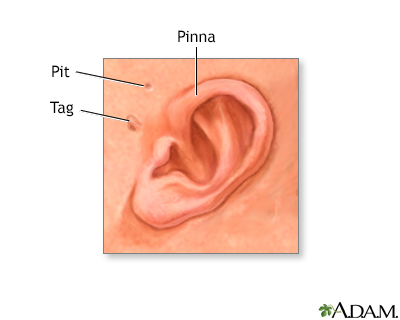Ear tag
Definition
An ear tag is a small skin tag or pit in front of the outside part of the ear.
Alternative Names
Preauricular tag; Preauricular pit
Considerations
Skin tags and pits just in front of the opening of the ear are common in newborn infants.
In most cases, these are normal. However, they can be associated with other medical conditions. It is important to point out skin tags or pits to your child's health care provider during the routine well-child exam.
Causes
Some causes of an ear tag or pit are:
- An inherited tendency to have this facial feature
- A genetic syndrome that includes having these pits or tags
- A sinus tract problem (an abnormal connection between the skin and tissue underneath)
When to Contact a Medical Professional
Your provider will most often find the skin tag during your first well-baby visit. However, call your provider if your child has bleeding, swelling, or discharge at the site.
What to Expect at Your Office Visit
Your provider will get a medical history and will do a physical exam.
Medical history questions about this condition might include:
- What exactly is the problem (skin tag, pit, or other)?
- Are both ears affected or only one?
- What other symptoms are present?
- Does the child respond normally to sounds?
Physical exam:
Your baby will be examined for other signs of disorders that are sometimes associated with ear tags or pits. A hearing test may be done if the child did not have the usual newborn screening test.
Gallery

References
Balest AL, Riley MM, Bogen DL. Neonatology. In: Zitelli BJ, McIntire SC, Nowalk AJ, eds. Zitelli and Davis' Atlas of Pediatric Physical Diagnosis. 7th ed. Philadelphia, PA: Elsevier; 2018:chap 2.
Demke JC, Tatum SA. Craniofacial surgery for congenital and acquired deformities. In: Flint PW, Francis HW, Haughey BH, et al, eds. Cummings Otolaryngology: Head and Neck Surgery. 7th ed. Philadelphia, PA: Elsevier; 2021:chap 187.
Patterson JW. Miscellaneous conditions. In: Patterson JW, ed. Weedon's Skin Pathology. 5th ed. Philadelphia, PA: Elsevier Limited; 2021:chap 20.